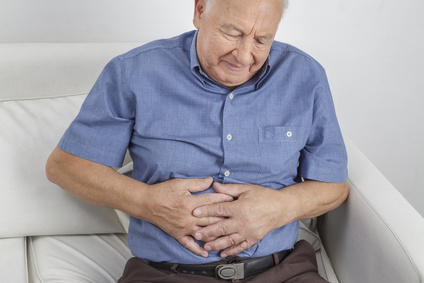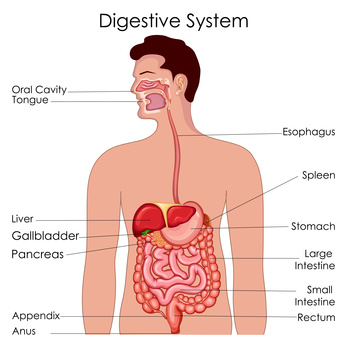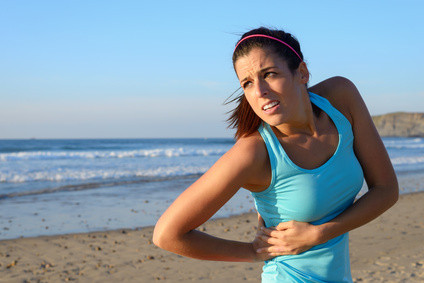Upper Stomach (Abdominal) Pain – Causes and Other Symptoms
Upper stomach pain is often used to describe upper abdominal pain in general. Although the stomach lies mainly in the left upper quadrant, it is difficult to correlate pain in this area specifically with stomach-related conditions. A number of other structures and organs lie in this part of the abdomen and have to be considered as possible causes of upper abdominal pain.
Any pain in this area is more likely to be associated with the stomach if it changes after eating – either the arises after eating, worsens or eases during or after a meal. Other symptoms may also be present which are indicative of a stomach, or upper gastrointestinal cause and this includes :
- Nausea and/or vomiting
- Excessive belching
- Stomach bloating – sensation of fullness or pressure
When assessing upper stomach pain, it is also important to consider conditions related to the organs in the thoracic cavity. The close proximity often means that chest pain (chest wall pain or pain of the organs/structures in the chest cavity) may be referred to or radiate to the upper abdomen.

In the context of this article, upper stomach pain will refer to pain in the left hypochondrium and epigastrium. Based on the anatomical location of the stomach, most of it lies within these abdominal quadrants. For more information on upper abdominal pain, refer to these articles on :
Causes of Upper Stomach Pain
Various conditions in the organs below may cause upper stomach pain. However, pain alone can be difficult to diagnose. Therefore it must be considered along with other symptoms. Diagnostic investigations may also need to be conducted to confirm the exact cause of upper stomach pain.
Esophagus
The esophagus runs from the throat, down the chest to the stomach that is located in the left upper quadrant of the abdomen.
- Esophagitis – inflammation of the esophagus lining.
- Esophageal ulcer – open sore in the lining of the esophagus.
- Esophageal rupture -perforation of the esophagus wall.
- Achalasia – failure of lower esophageal sphincter (LES) to relax.
- Mallory-Weiss tear – tear of the esophagus as the junction with the stomach.
Other symptoms of esophagus problems that may be present includes :
- Esophagus pain during and immediately after eating
- Chest pain after eating
- Excessive belching
Stomach
The stomach is located in the left upper quadrant of the abdomen and is largely tucked under the left rib cage. However, it can extend across to the upper middle abdominal region, particularly when stretched with food.
- Gastritis – inflammation of the stomach lining.
- Gastroenteritis – infection of the stomach due to food or water borne pathogens or toxins.
- Stomach ulcer – open sore in the lining of the stomach.
- Hiatal hernia – protrusion of a portion of the stomach through the diaphragmatic opening.
- Gastric outlet obstruction – blockage of the passage of food/chyme out of the stomach into the intestines.
Other symptoms of stomach problems that may be present include :
- Nausea and/or vomiting – projectile vomiting
- Excessive belching
- Stomach pain after eating or when hungry
- Stomach bloating

Small Intestine (Duodenum)
The small intestine is the longest part of the gut and is coiled in the middle of the abdomen. The first part of the small intestine known as the duodenum leads from the stomach. It is conditions in the duodenum that is more likely to cause upper stomach pain.
- Gastroenteritis – infection of the intestinal lining due to food or water borne pathogens or toxins.
- Duodenal ulcer – open sore in the lining of the duodenum. Refer to Peptic Ulcer.
- Gallstones – calculi in the gallbladder or bile ducts (gallbaldder stones or bile duct stones).
- Cholecystitis – inflammation of the gallbladder.
- Pancreatitis – inflammation of the pancreas.
- Cholangitis – inflammation of the bile ducts.
- Food malabsorption, intolerance – difficulty or inability to digest or absorb certain nutrients.
Other symptoms that may be present include :
- Nausea and/or vomiting – projectile vomiting, bile vomiting
- Fever with/without chills
- Yellow skin – jaundice
- Stools – pale or clay colored, steatorrhea (fatty stools)
- Dark urine
- Pain that starts shortly after eating and may be related to certain foods/drinks
- Malabsorption syndromes – signs of mineral or vitamin deficiencies, unintentional weight loss
- Change in bowel habit– diarrhea, constipation
Large Intestine (Transverse Colon and Flexures)
The large intestine continues from the end of the small intestine. It runs along with the periphery of the abdomen, starting at the cecum (lower right abdomen), continuing to the ascending colon, then transverse colon, descending colon, sigmoid colon and then to the rectum.
- Irritable bowel syndrome
- Inflammatory bowel disease
- Splenic flexure syndrome (trapped gas)
- Colitis
Other symptoms of large intestine problems that may be present include :
- Change in bowel movement – constipation, diarrhea
- Blood in stool (hematochezia ~ fresh blood in stool, melena ~ dark blood in stool)
- Mucus in stool
- Excessive flatulence
Kidney
The kidneys, right and left, are located in upper flanks and towards the back. The ureters that lead from the kidneys run down the sides of the abdomen to the urinary bladder in the pelvis.
- Kidney stone (renal calculus)
- Nephritis
- Renal abscess
- Renal carcinoma
- Acute kidney failure
- Polycystic kidney disease
- Diabetic nephropathy
- UTIs (urinary tract infection – upper ureter)

Kidney pain is felt in the back and flank/loin. Other symptoms that may be present include :
- Dysuria – pain, burning, discomfort upon urination
- Hematuria – blood in urine
- Proteinuria – protein in urine, foamy urine
- Frequent urination
- Urinary retention
- Urinary incontinence
- Changes in urine color
- Changes in urine output
- Straining, hesitancy or post micturition dribble
Spleen
- Splenic infarct
- Splenic rupture
- Splenomegaly – (enlarged spleen rarely causes pain of the spleen but may press against surrounding structures)
Refer to Spleen Pain for other causes. Other symptoms that may be present include :
- Pain aggravated by deep breathing, especially inspiration.
- Pain after eating large meals.
Abdominal Wall
- Skin – dermatitis, shingles, hematoma, trauma
- Muscle – muscle strain, torn muscle
- Rib – trauma, fracture
- Peritoneum – peritonitis
Other symptoms may include :
- Skin features – rash, itching, redness
- Pain worse upon movement, standing erect, bending forward, lying on side
- Pain upon breathing
Other Causes
- Cardiac chest pain – myocardial infarction (heart attack), pericarditis
- Lung chest pain – pneumonia, pleuritis
- Chest wall pain
- Abdominal aortic dissection
- Abdominal abscess – retroperitoneal, subphrenic (below diaphragm)
Last updated on September 17, 2018.





